Sustainable and Self-Sufficient Fresh Water Through MED Desalination Powered by a CPV-T Solar Hybrid Collector: A Numerical and Experimental Study
Abstract
1. Introduction
1.1. Motivation
- Unsafe water is responsible for 1.2 million deaths each year;
- 6% of deaths in low-income countries are the result of unsafe water sources;
- One-in-four people do not have access to safe drinking water;
- 6% of the world does not have access to an improved water source. (According to the World Health Organization (WHO), improved drinking-water sources are defined as those that are likely to be protected from outside contamination, and from fecal matter in particular.)
- Within this publication, the authors provide answers to the following research questions:
- Can energy self-sufficiency of an MED plant be achieved?
- What are the design requirements for the hybrid absorber if adjusted to the MED’s energetic needs?
- What off-the-shelf components are available to design an efficient yet cost-effective system?
- What thermal and electrical efficiencies can be achieved?
- Which geographic locations are suitable to deploy this system from a metrological point of view?
- What is the maximum achievable fresh water output per m2 collector area?
- How do thermal and electrical energy storage affect these KPIs?
1.2. State of the Art
1.2.1. State of the Art in Seawater Desalination
- Thermal processes, including multi-stage flash (MSF), multi-effect distillation (MED) and mechanical vapor compression (MVC).
- Mechanical membrane processes, including reverse osmosis (RO) and electro-dialysis (ED), which are limited to brackish water.
1.2.2. Working Principle of the MED System
- The general advantages of MED systems can be summarized as follows:
- Low energy demand compared to other thermal desalination processes;
- Does not require (chemical) water pretreatment;
- Tolerant to quality and condition of water supply;
- Highly reliable, simple system with good scalability;
- Low operating and maintenance costs;
- Process can be adapted to heat source (process waste heat, solar heat);
- Advantage of low operating temperature:
- ○
- Avoids crust formation on the evaporator;
- ○
- Results in low thermal losses in general;
- ○
- Allows state of the art CPV-T systems to be used as primary energy source.
1.2.3. State of the Art in CPV-T Systems
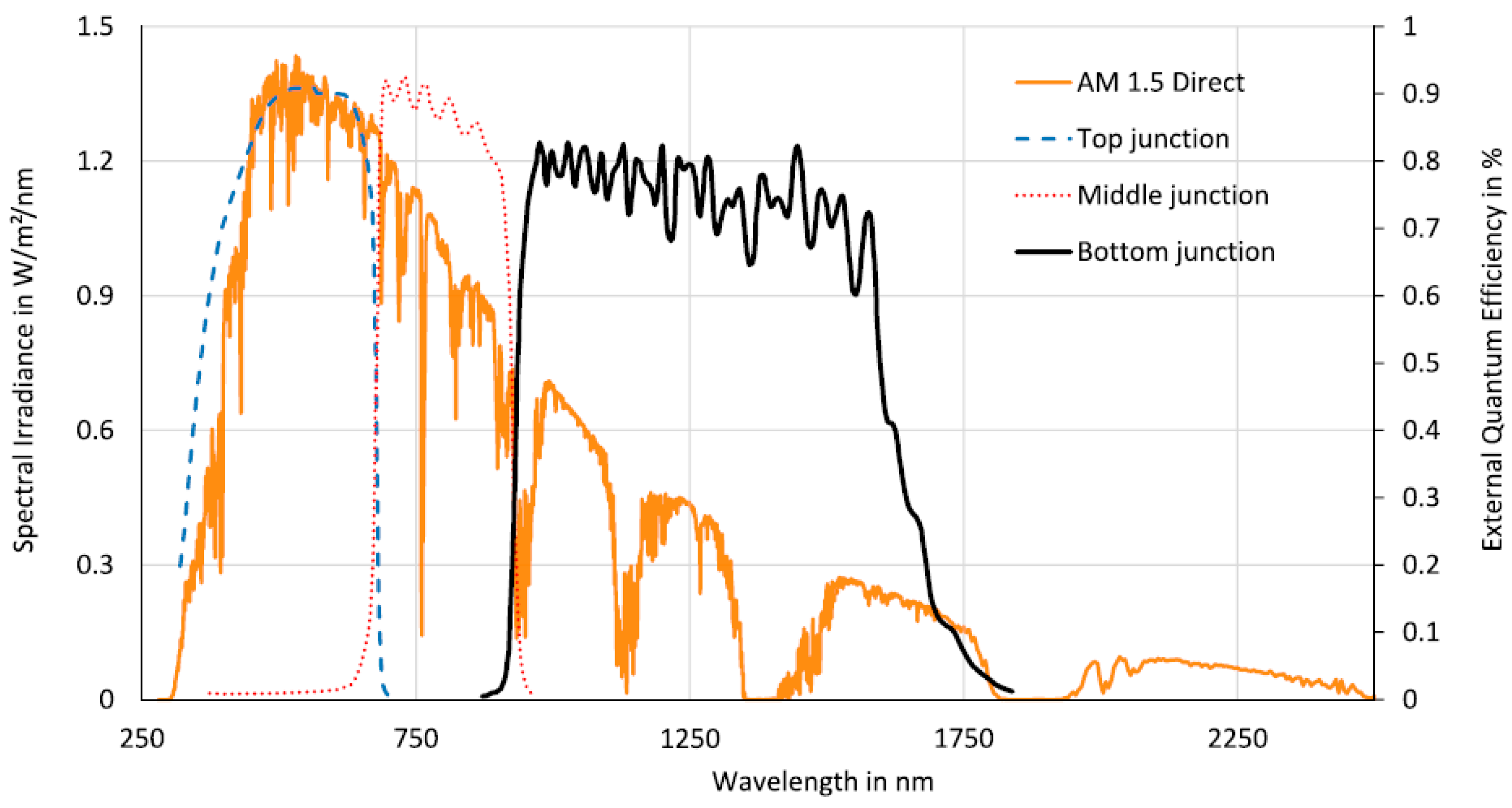
2. Hardware and Simulation System Description
- The advantages of the NEWSUN concept can be summarized as follows:
- Use of the CPV cells’ waste heat as process heat for potable water production.
- The optical elements (i.e., mirrors) experience a dual use (CSP and CPV), which leads to a significant cost reduction while increasing the overall system efficiency.
- Highly efficient multi-junction concentrator cells can be implemented.
- If the hybrid absorber is combined with a water treatment plant by multi-effect distillation (MED), an energy self-sufficient/energy generating system is created, which offers low operating costs at high overall efficiency.
- In addition to the huge global market of desalination, the “co-generation absorber module” is of course also suitable for other applications, such as clinical water treatment, or industrial processes where electricity and heat are needed.
2.1. Parabolic Trough Hybrid Absorber
2.1.1. CPV Cell Selection
2.1.2. Hybrid Absorber Design
2.1.3. Experimental Characterization of the Hybrid Absorber
2.1.4. Thermal, Electrical and Total Efficiency
- (a)
- The “average cell efficiency” is based on effective solar cell area, neglecting spaces between cells.
- (b)
- The “maximum cell efficiency” is 30%, if the parabolic mirror shape is ideally adjusted and the cells are positioned perfectly in the focal line.
- (c)
- The efficiency term “system efficiency” includes the unused spaces between the PV cells. The peak value is 28.5%.
2.2. Overall Numerical Model (TRNSYS)
2.2.1. Selection of Geographic Locations and Climatic Conditions
2.2.2. Simulation Model Setup
2.2.3. Component Models
- Parabolic Trough Hybrid Absorber
- MED plant
- Thermal energy storage
- Electrical storage and inverter
- Pipes
- Electricity consumption
2.2.4. System Control
- Collector circuit control strategy
- MED circuit control strategy
3. Results
4. Discussion
4.1. Limitations of the Simulation Approach
4.2. Comparison with Competing Technologies
- (a)
- Higher system efficiencies and lower installation space requirements.
- (b)
- Techno-economic considerations.
- (c)
- Geo-political and material resource related considerations.
5. Summary and Outlook
Author Contributions
Funding
Data Availability Statement
Acknowledgments
Conflicts of Interest
Nomenclature
| AM | air mass |
| CAM | co-generation absorber module |
| c-Si | crystalline silicone |
| CPV | concentrator photovoltaics |
| CPV-T | concentrator photovoltaic-thermal |
| CPV-T-TE | concentrated photovoltaic-thermal-thermoelectric |
| CSP | concentrating solar power |
| DNI | direct normal irradiance |
| ECOSun | economic co-generation of concentrated sunlight |
| ED | electro-dialysis |
| EU | European Union |
| FSOC | fractional state of char |
| GHG | greenhouse gas |
| GOR | gained output ratio |
| HTF | heat transfer fluid |
| IAM | incidence angle modifier |
| KPI | key performance indicators |
| MED | multi-effect distillation |
| MPP | maximum power point |
| MSF | multi-stage flash |
| MCV | mechanical vapor compression |
| NEWSUN | Nexus of Electricity and Water Supply for Urban Needs |
| NOCT | nominal operating (PV) cell temperature |
| PCB | printed circuit board |
| Pi | pipe |
| PTC | parabolic trough collectors |
| Pu | pump |
| PV-T | photovoltaic-thermal |
| RO | reverse osmosis |
| Si | silicone |
| TES | thermal energy storage |
References
- Parfit, M. Water—The Power, Promise, and Turmoil of North America’s Fresh Water; National Geographic Society: Washington, DC, USA, 1993. [Google Scholar]
- Palenzuela, P.; Alarcón-Padilla, D.-C.; Zaragoza, G. Concentrating Solar Power and Desalination Plants—Engineering and Economics of Coupling Multi-Effect Distillation and Solar Plants; Springer International Publishing: Cham, Switzerland, 2015. [Google Scholar]
- Tsegai, D.; Medel, M.; Augenstein, P.; Huang, Z. Drought in Numbers 2022—Restoration for Readiness and Resilience; United Nations Convention to Combat Desertification (UNCCD): Bonn, Germany, 2022. [Google Scholar]
- U.S. Department of Energy. Energy Demands on Water Resources: Report to Congress on the Interdependency of Energy and Water; U.S. Department of Energy: Washington, DC, USA, 2006. [Google Scholar]
- European Investment Bank. How Bad Is the Ukraine War for the European Recovery? EIB Economics Department: Luxembourg, 2022. [Google Scholar]
- Biermayr, P. Erneuerbare Energie in Zahlen 2016; Bundesministerium für Land- und Forstwirtschaft, Umwelt und Wasserwirtschaft: Vienna, Austria, 2016. [Google Scholar]
- Sharples, J.; Judge, A. Russian gas supplies to Europe: The likelihood, and potential impact, of an interruption in gas transit via Ukraine. The European Geopolitical Forum—EGF Energy Special Contribution. 20 March 2014. Available online: http://www.gpf-europe.com/upload/iblock/c52/egf_energy_special_contribution_pdf.pdf (accessed on 26 November 2024).
- Comoplexity Science Hub Vienna. Austria Without Russian Natural Gas? Expected Economic Impacts of a Drastic Gas Supply Shock and Mitigation Strategies. 24 May 2022. Available online: https://www.csh.ac.at/wp-content/uploads/2022/05/2022-05-24-CSH-Policy-Brief-Gas-Shock-Long-Version-EN.pdf (accessed on 31 August 2022).
- Our World in Data. Per Capita CO2 Emissions by Sector, World, 2019. 2020. Available online: https://ourworldindata.org/grapher/per-capita-co2-sector (accessed on 20 February 2023).
- Ritchie, H.; Roser, M. Clean Water and Sanitation. Our World in Data. 2021. Available online: https://ourworldindata.org/water-access (accessed on 20 February 2023).
- Nejat, P.; Jomehzadeh, F.; Taheri, M.M.; Gohari, M.; Abd, M.Z. A global review of energy consumption, CO2 emissions and policy in the residential sector (with an overview of the top ten CO2 emitting countries). Renew. Sustain. Energy Rev. 2015, 43, 843–862. [Google Scholar] [CrossRef]
- Akashi, O.; Hanaoka, T.; Matsuoka, Y.; Kainuma, M. A projection for global CO2 emissions from the industrial sector through 2030 based on activity level and technology changes. Energy 2011, 36, 1855–1867. [Google Scholar] [CrossRef]
- Le Houérou, H.N. Climate change, drought and desertification. J. Arid. Environ. 1996, 34, 133–185. [Google Scholar] [CrossRef]
- Polemio, M.; Casarano, D. Climate change, drought and groundwater availability in southern Italy. Geol. Soc. Lond. Spec. Publ. 2008, 288, 39–51. [Google Scholar] [CrossRef]
- Maddocks, A.; Young, R.S.; Reig, P. Ranking the World’s Most Water-Stressed Countries in 2040; World Resources Institute: Washington, DC, USA, 16 August 2015; Available online: http://www.wri.org/blog/2015/08/ranking-world%E2%80%99s-most-water-stressed-countries-2040 (accessed on 29 June 2017).
- Heihsel, M.; Lenzen, M.; Malik, A.; Geschke, A. The carbon footprint of desalination: An input-output analysis of seawater reverse osmosis desalination in Australia for 2005–2015. Desalination 2019, 454, 71–81. [Google Scholar] [CrossRef]
- Klaimi, R.; Sabla, Y. GHG Emission Reduction Assessment for Desalination Systems through Carbon Capture and Renewable Energy Options. In Computer Aided Chemical Engineering; Elsevier: Amsterdam, The Netherlands, 2020; pp. 1081–1086. [Google Scholar]
- Fischetti, M. Fresh from the Sea. Sci. Am. 2007, 297, 118–119. [Google Scholar] [CrossRef]
- Khawadji, A.D.; Kutubkhanah, I.K.; Wie, J.-M. Advances in seawater desalination technologies. Desalination 2008, 221, 47–69. [Google Scholar] [CrossRef]
- Henthorne, L.; Boysen, B. State-of-the-art of reverse osmosis desalination pretreatment. Desalination 2015, 356, 129–139. [Google Scholar] [CrossRef]
- Al-Shammiri, M.; Safar, M. Multi-effect distillation plants: State of the art. Desalination 1999, 126, 45–59. [Google Scholar] [CrossRef]
- Ophir, A.; Lokiec, F. Advanced MED process for most economical sea water desalination. Desalination 2005, 183, 187–198. [Google Scholar] [CrossRef]
- Michels, T. Recent achievements of low temperature multiple effect desalination in the western areas of Abu Dhabi, UAE. Desalination 1993, 93, 111–118. [Google Scholar] [CrossRef]
- Trieb, F.; Müller-Steinhagen, H. Concentrating solar power for seawater desalination in the Middle East and North Africa. Desalination 2008, 220, 165–183. [Google Scholar] [CrossRef]
- Felsberger, R.; Buchroithner, A.; Gerl, B.; Wegleiter, H. Conversion and Testing of a Solar Thermal Parabolic Trough Collector for CPV-T Application. Energies 2020, 13, 6142. [Google Scholar] [CrossRef]
- NREL. Best Research-Cell Efficiency Chart. Available online: https://www.nrel.gov/pv/cell-efficiency.html (accessed on 27 October 2022).
- Pérez-Higueras, P.; Eduardo, F. Fernández. High Concentrator Photovoltaics—Fundamentals, Engineering and Power Plants; Springer—Green Energy Technology: Berlin/Heidelberg, Germany, 2015. [Google Scholar]
- Buchroithner, A.; Gerl, B.; Felsberger, R.; Wegleiter, H. Design and operation of a versatile, low-cost, high-flux solar simulator for automated CPV cell and module testing. Sol. Energy 2021, 228, 387–404. [Google Scholar] [CrossRef]
- Omar, M.; Sharaf, Z. Concentrated photovoltaic thermal (CPVT) solar collectorsystems: Part I—Fundamentals, design considerations and current technology. Renew. Sustain. Energy Rev. 2015, 50, 1500–1565. [Google Scholar]
- Gibart, C. Study of and tests on a hybrid photovoltaic-thermal collector using concentrated sunlight. Sol. Cells 1981, 4, 71–79. [Google Scholar] [CrossRef]
- Rios, M.; Edenburn, M.W.; Allen, P.A. Cost effectiveness of concentrating photovoltaic-thermal (PVT) systems vs. side-by-side systems for two intermediate applications. In Proceedings of the IEEE 15th Photovoltaic Specialists Conference, Kissimmee, FL, USA, 11 May 1981. [Google Scholar]
- Pérez-Higueras, P.; Adame-Sánchez, C.; Hontoria-García, L.; Rus-Casas, C.; González-Rodríguez, A.; Aguilar-Peña, J.D.; Gallego-Álvarez, F.J.; González-Luchena, I. High-Concentrator Photovoltaic Power Plants: Energy Balance and Case Studies. In High Concentrator Photovoltaics; Green Energy and Technology; Pérez-Higueras, P.F.E., Ed.; Springer: Berlin/Heidelberg, Germany, 2015; pp. 443–477. [Google Scholar]
- Joe, S. Performance of a concentrating photovoltaic/thermal solar collector. Sol. Energy 2005, 78, 211–222. [Google Scholar]
- DelCol, D.; Bortolato, M.; Padovan, A.; Quaggia, M. Experimental and Numerical Study of a Parabolic Trough Linear CPVT System. Energy Procedia 2014, 57, 255–264. [Google Scholar] [CrossRef]
- Bellini, E. Concentrating Photovoltaic-Thermal System with 91% Efficiency. PV Magazine. 6 October 2020. Available online: https://www.pv-magazine.com/2020/10/06/concentrating-photovoltaic-thermal-system-with-91-efficiency/ (accessed on 31 August 2022).
- Riahi, A.; Ali, A.B.H.; Fadhel, A.; Guizani, A.; Balghouthi, M. Performance investigation of a concentrating photovoltaic thermal hybrid solar system combined with thermoelectric generators. Energy Convers. Manag. 2020, 205, 112377. [Google Scholar] [CrossRef]
- Yang, F.; Wang, H.; Zhang, X.; Tian, W.; Hua, Y.; Dong, T. Design and experimental study of a cost-effective low concentrating photovoltaic/thermal system. Sol. Energy 2018, 160, 289–296. [Google Scholar] [CrossRef]
- Felsberger, R.; Buchroithner, A.; Gerl, B.; Schweighofer, B.; Wegleiter, H. Design and testing of concentrated photovoltaic arrays for retrofitting of solar thermal parabolic trough collectors. Appl. Energy 2021, 300, 117427. [Google Scholar] [CrossRef]
- Buchroithner, A.; Felsberger, R.; Preßmair, R. Highly Efficient Solar Co-Generation in Parabolic Trough Collectors Using Hybrid Absorber Technologies: Potentials and Challenges. In Proceedings of the PVcon 2022, Ankara, Türkiye, 5–7 August 2022. [Google Scholar]
- Giannuzzi, A.; Sansoni, P.; Pierucci, G.; Francini, F.; Sani, E.; Mercatelli, L.; Jafrancesco, D.; Fontani, D. Development of a secondary collector for an existing solar trough. Trans. Eng. Sci. 2013, 88. Available online: https://www.researchgate.net/publication/269631728_Development_of_a_secondary_collector_for_an_existing_solar_trough (accessed on 26 November 2024).
- Srivastava, S.; Reddy, K.S. Simulation studies of thermal and electrical performance of solar linear parabolic trough concentrating photovoltaic system. Sol. Energy 2017, 149, 195–213. [Google Scholar] [CrossRef]
- Reddy, K.S.; Nikhilesh, R. Optical analysis and thermal management of 2-cell strings linear concentrating photovoltaic system. In AIP Conference Proceedings; AIP: Melville, NY, USA, 2016. [Google Scholar]
- AZUR SPACE Solar Power GmbH. Concentrator Triple Junction Solar Cell [Datasheet]. 2016. Available online: http://www.azurspace.com/images/products/0004355-00-01_3C44_AzurDesign_10x10.pdf (accessed on 10 October 2020).
- International Energy Agency. Solar Heat for Industrial Processes. Available online: http://task33.iea-shc.org/ (accessed on 14 November 2024).
- Vannoni, C.; Battisti, R.; Drigo, S. Potential for Solar Heat in Industrial Processes; IEA SHC Task 33 and SolarPaces Task IV: Solar Heat in Industrial Processes; CIEMAT: Madrid, Spain, 2008. [Google Scholar]
- Fortuin, S.; Stryi-Hipp, G. Solar Collectors, Non-concentrating. In Solar Energy; Richter, C.L.D.G., Ed.; Springer: New York, NY, USA, 2016. [Google Scholar]
- Kalogirou, S. The potential of solar industrial process heat applications. Appl. Energy 2003, 76, 337–361. [Google Scholar] [CrossRef]
- Mohammadi, K.; Saghafifar, M.; Ellingwood, K.; Powell, K. Hybrid concentrated solar power (CSP)-desalination systems: A review. Desalination 2019, 468, 114083. [Google Scholar] [CrossRef]
- Felsberger, R.; Buchroithner, A.; Gerl, B.; Schweighofer, B.; Preßmair, R.; Mitter, T.; Wegleiter, H. Optical performance and alignment characterization of a parabolic trough collector using a multi-junction CPV solar cell. Sol. Energy 2022, 239, 40–49. [Google Scholar] [CrossRef]
- SPF—Institute for Solar Technology. C1549—Solar Collector Factsheet NEP Polytrough 1800. 2021. Available online: https://eif-wiki.feit.uts.edu.au/_media/technical:renewables:111010_polytrough1200b_techspec_v10.pdf (accessed on 26 November 2024).
- Luo, T.; Young, R.; Reig, P. Aqueduct Projected Water Stress Country Rankings; World Resources Institute: Washington, DC, USA, 2015. [Google Scholar]
- Meteotest. Global Meteorological Database Version 8, Software and Data for Engineers, Planers and Education; Meteotest: Bern, Switzerland, 2020. [Google Scholar]
- TESS. TESSLibs 17—Component Libraries for the TRNSYS Simulation Environment, Volume 10: Solar Library Mathematical Reference; Thermal Energy System Specialists: Madison, WI, USA, 2012. [Google Scholar]
- Santos, D.; Azgın, A.; Castro, J.; Kizildag, D.; Rigola, J.; Tunçel, B.; Turan, R.; Preßmair, R.; Felsberger, R.; Buchroithner, A. Thermal and fluid dynamic optimization of a CPV-T receiver for solar co-generation applications: Numerical modelling and experimental validation. Renew. Energy 2023, 211, 87–99. [Google Scholar] [CrossRef]
- Hajjaj, M.; Tilioua, A.; Mellaikhafi, A.; Bouaaddi, A. Thermal Performance Analysis of Parabolic Trough Solar Collector System in Climatic Conditions of Errachidia city, Morocco. J. Adv. Sci. Technol. Eng. Syst. 2020, 5, 217–223. [Google Scholar] [CrossRef]
- TESS. TESSLibs 17—Component Libraries for the TRNSYS Simulation Environment, Volume 03: Electrical Library Mathematical Reference; Thermal Energy System Specialists: Madison, WI, USA, 2012. [Google Scholar]
- Frantz, C.; Seifert, B. Thermal Analysis of a Multi Effect Distillation Plant Powered by a Solar Tower Plant. Energy Procedia 2015, 69, 1928–1937. [Google Scholar] [CrossRef]
- TRNSYS. TRNSYS 17: A Transient System Simulation Program, Volume 4: Mathematical Reference; Solar Energy Laboratory, University of Wisconsin-Madison: Madison, WI, USA, 2014. [Google Scholar]
- EU. Amtsblatt L239 der Europäischen Union, DELEGIERTE VERORDNUNG (EU) Nr. 812/2013. 2013. Available online: https://eur-lex.europa.eu/legal-content/DE/TXT/PDF/?uri=OJ:L:2013:239:FULL&from=DE (accessed on 5 November 2018).
- Jinko Solar Co., Ltd. Tiger Neo N-type 54HL4-(V) 410-430 Watt MONO-FACIAL MODULE. August 2021. Available online: https://www.greenenergy4seasons.be/wp-content/uploads/2022/08/JKM425.pdf (accessed on 15 March 2023).
- OST—Ostschweizer Fachhochschule. SPF Institut für Solartechnik. 2023. Available online: https://www.ost.ch/de/forschung-und-dienstleistungen/technik/erneuerbare-energien-und-umwelttechnik/spf-institut-fuer-solartechnik (accessed on 15 March 2023).
- SPF Testing, Institut für Solartechnik SPF, Hochschule für Technik Rapperswil. Solar Collector Factsheet Savo-Solar SF500-15DG. 15 December 2016. Available online: https://meriauragroup.com/wp-content/uploads/archive/savosolar.com/products/collectors/index.html (accessed on 15 March 2023).
- Hammad, B.; Al-Sardeah, A.; Al-Abed, M.; Nijmeh, S.; Al-Ghandoor, A. Performance and economic comparison of fixed and tracking photovoltaic systems in Jordan. Renew. Sustain. Energy Rev. 2017, 80, 827–839. [Google Scholar] [CrossRef]
- Mills, R. Under a Cloud: The Future of Middle East Gas Demand; Center on Global Energy Policy at COLUMBIA SIPA: New York, NY, USA, 2020. [Google Scholar]
- GASREG—Gas Regulation Authority. Natural Gas Pricing. Egyptian Ministry of Petroleum. 2024. Available online: https://www.gasreg.org.eg/natural-gas-pricing/ (accessed on 22 November 2024).
- Kurup, P.; Turchi, C.S. Parabolic Trough Collector Cost Update for the System Advisor Model (SAM); NREL—National Renewable Energy Laboratory: Golden, CO, USA, 2015. [Google Scholar]
- Kurup, P.; Glynn, S.; Akar, S. Manufacturing Cost Analysis of Advanced Parabolic Trough Collector. In Proceedings of the SolarRPACES 2020: 26th International Conference on Concentrating Solar Power and Chemical Energy Systems, Freiburg, Germany, 28 September–2 October 2020; Volume 2445. No. 1. [Google Scholar]
- ERA LEARN. Project: Economic COgeneration by Efficiently COncentrated SUNlight. Austrian Research Promotion Agency—Österreichische Forschungsförderungsgesellschaft mbH (FFG). 2023. Available online: https://www.era-learn.eu/network-information/networks/solar-cofund-2/solar-cofund-2-joint-call/economic-cogeneration-by-efficiently-concentrated-sunlight (accessed on 22 November 2024).
- Weiss, W.; Rommel, M. Process Heat Collectors—State of the Art within Task 33/IV; Solar Heating and Cooling Executive Committee of the International Energy Agency (IEA): Paris, France, 2008. [Google Scholar]
- Krüger, D.R.; Fischer, S.; Fischer, S.; Nitz, P.; Labairu, J.I. Chancen für den Einsatz konzentrierender Kollektoren in Mitteleuropa. In Proceedings of the 31. Symposium Solarthermie und Innovative Wärmesysteme, online, 27–30 April 2021. [Google Scholar]
- Daneshazarian, R.; Cuce, E.; Cuce, P.M.; Sher, F. Concentrating photovoltaic thermal (CPVT) collectors and systems: Theory, performance assessment and applications. Renew. Sustain. Energy Rev. 2018, 81, 473–492. [Google Scholar] [CrossRef]
- Cortés, F.; Ibarra, M.; Moser, F.; Muñoz, I.; Crespo, A.; Murray, C. Techno-economical evaluation of parabolic trough collectors systems for steam processes in the Chilean industry. AIP Conf. Proc. 2018, 2033, 150003. [Google Scholar]
- Wang, Q.; Yao, Y.; Shen, Y.; Shen, Z.; Yang, H. A mutually beneficial system incorporating parabolic trough concentrating solar power system with photovoltaics: A comprehensive techno-economic analysis. Appl. Energy 2024, 360, 122834. [Google Scholar] [CrossRef]
- Simeu, C.T.; Njomo, D.; Chara-Dackou, V.S.; Babikir, M.H. Comparative study of thermal performance improvement of parabolic trough solar collector using different heat transfer fluids, economic and environmental analysis of power generation. Results Eng. 2024, 23, 102353. [Google Scholar] [CrossRef]
- Marsillac, E. COVID-19 effects on the global PV supply chain. In Proceedings of the 2021 IEEE 48th Photovoltaic Specialists Conference (PVSC), Fort Lauderdale, FL, USA, 20–25 June 2021; pp. 2630–2631. [Google Scholar]
- Fthenakis, V. How Long Does it Take for Photovoltaics To Produce the Energy Used? Communities Industry—The Magazine for Professional Engineers, Vol. January/February 2012. Available online: http://www.clca.columbia.edu/236_PE_Magazine_Fthenakis_2_10_12.pdf (accessed on 26 November 2024).
- International Energy Agency. Special Report on Silar PV Global Supply Chains; International Energy Agency: Paris, France, 2022. [Google Scholar]
- Liu, F.; van den Bergh, J.C.J.M. Differences in CO2 emissions of solar PV production among technologies and regions: Application to China, EU and USA. Energy Policy 2022, 138, 111234. [Google Scholar] [CrossRef]
- Duran, A.S.; Atasu, A.; Van Wassenhove, L.N. Cleaning after solar panels: Applying a circular outlook to clean energy research. Int. J. Prod. Res. 2021, 60, 211–230. [Google Scholar] [CrossRef]
- Aydin, E.; Buchroithner, A.; Felsberger, R.; Preßmair, R.; Azgın, A.; Turan, R.; Keçeci, A.E.; Bektaş, G.; Akinoglu, B. Development of low-cost c-Si-based CPV cells for a solar co-generation absorber in a parabolic trough collector. Energies 2024, 17, 2890. [Google Scholar] [CrossRef]
- Buchroithner, A.; Felsberger, R.; Mitter, T.; Preßmair, R. Mapping Solar Flux Distribution in Parabolic Trough Collectors to Assess Optical Performance. In Proceedings of the SolarPACES—Solar Power and Chemical Energy Systems, Albuquerque, NM, USA, 27–30 September 2022. [Google Scholar]

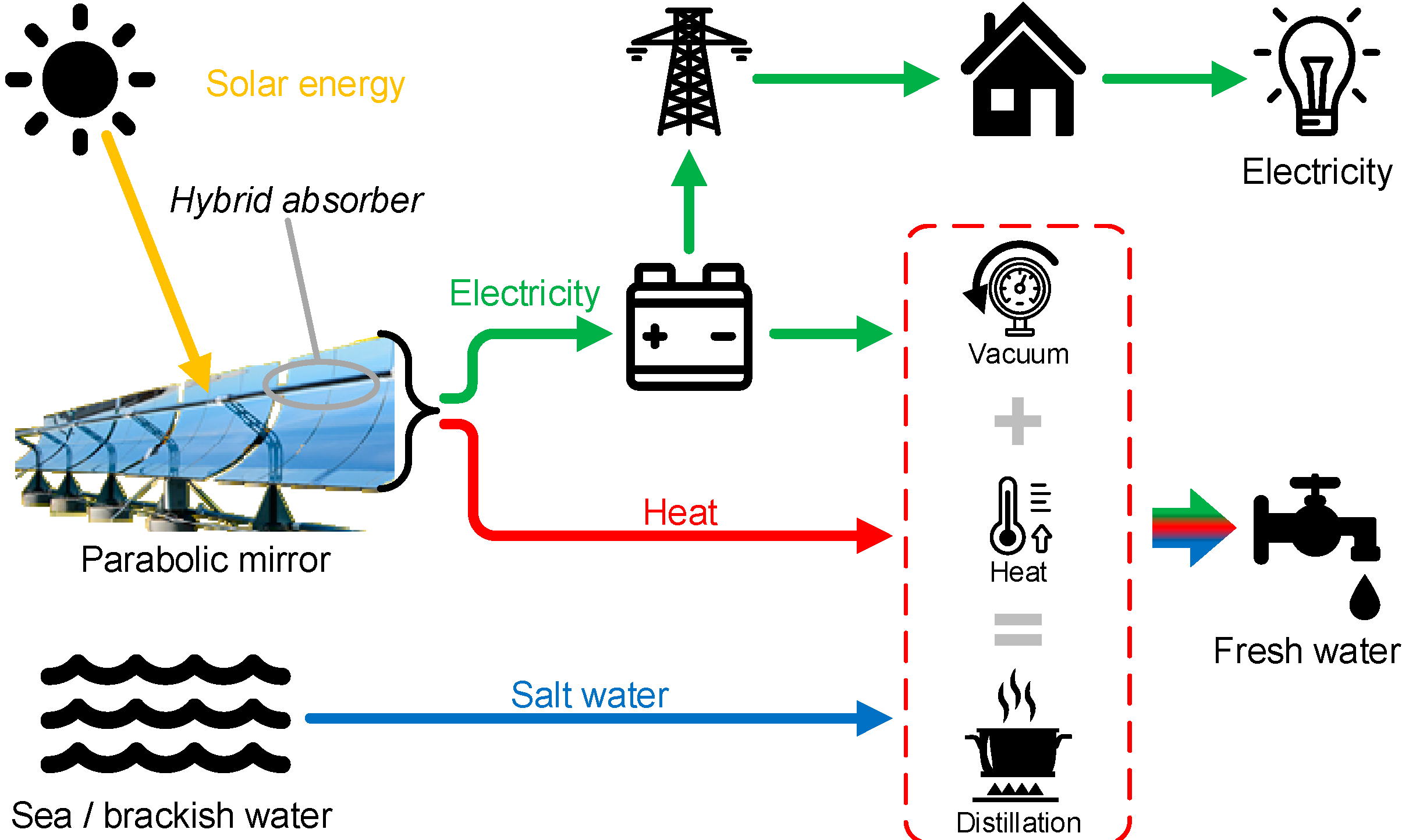

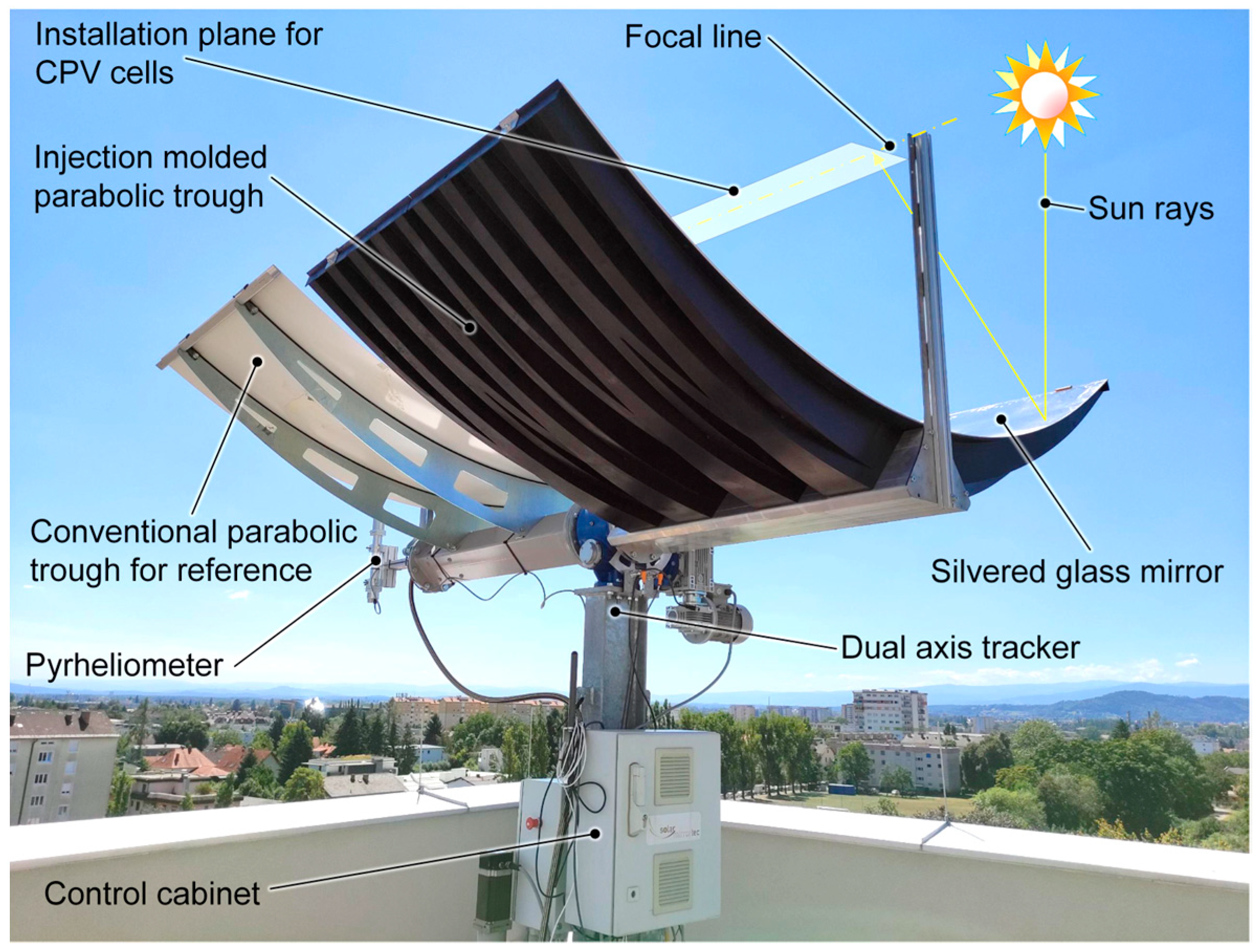
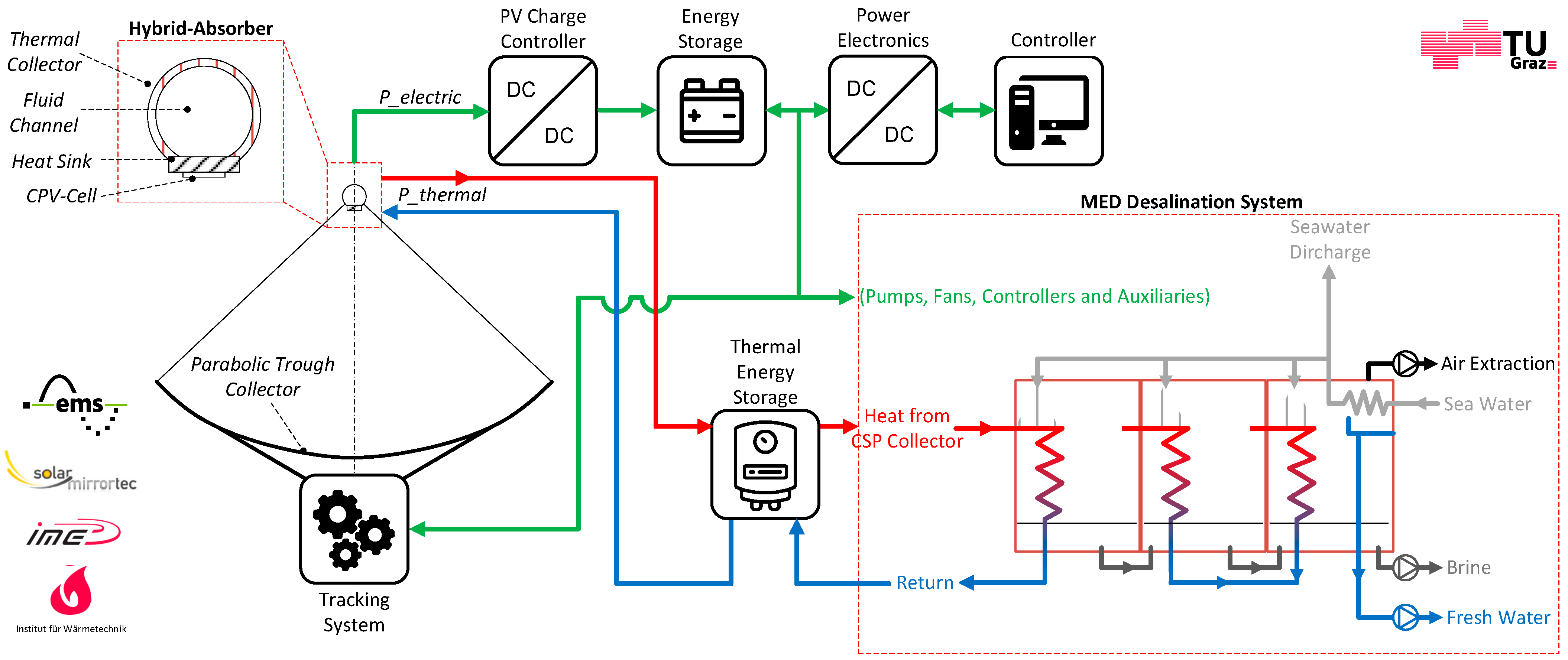
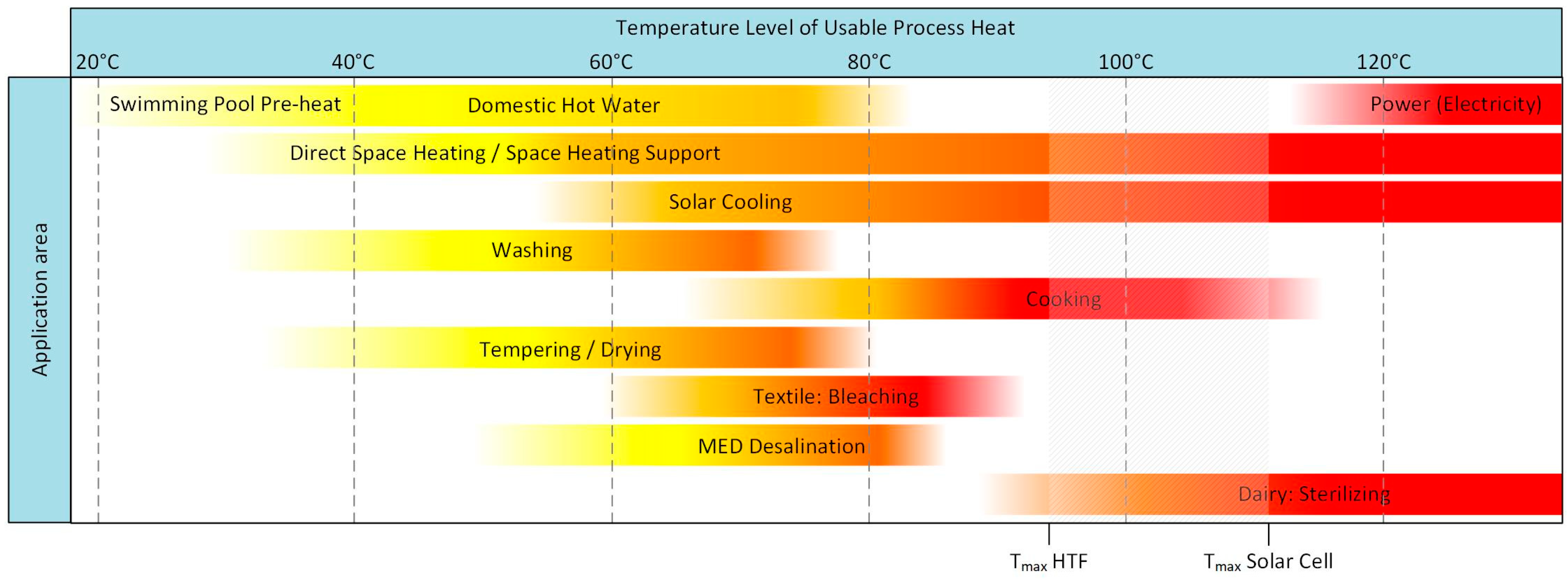



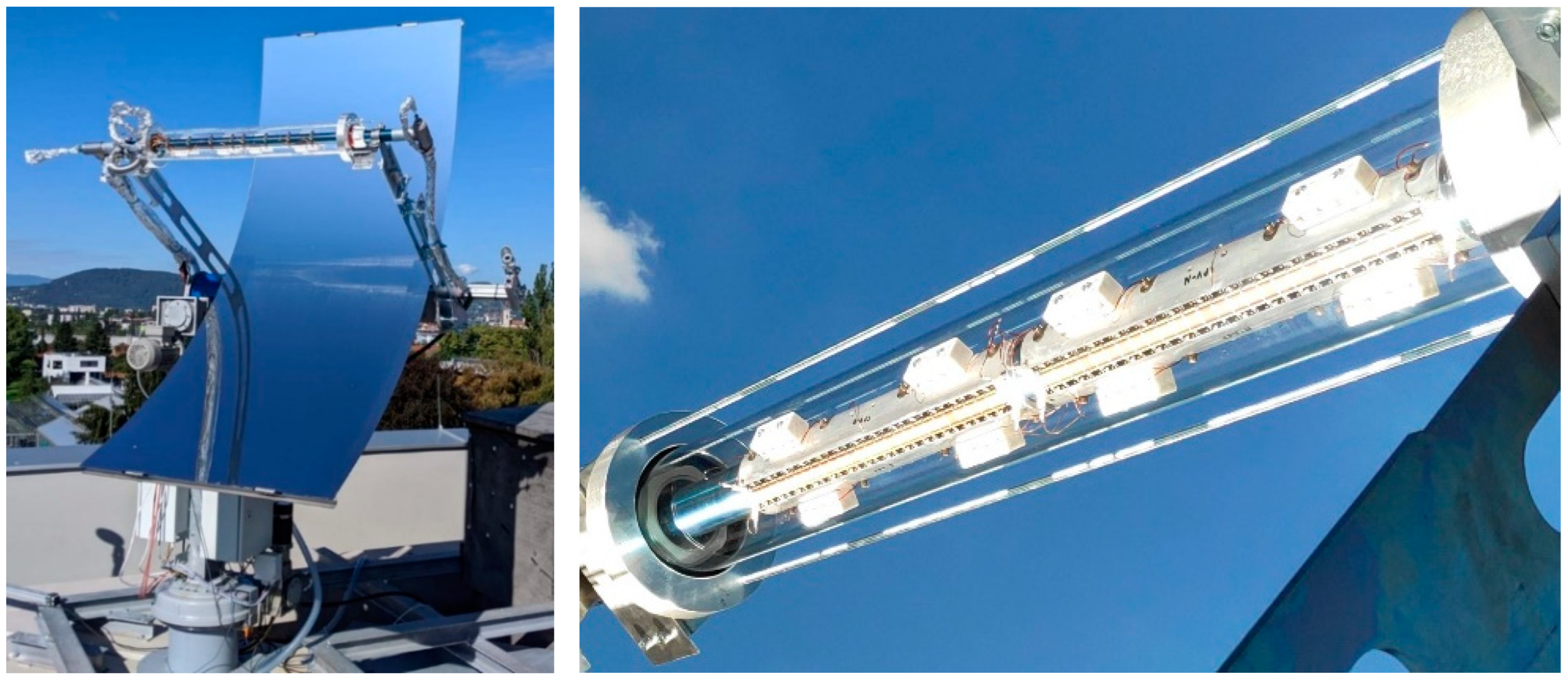
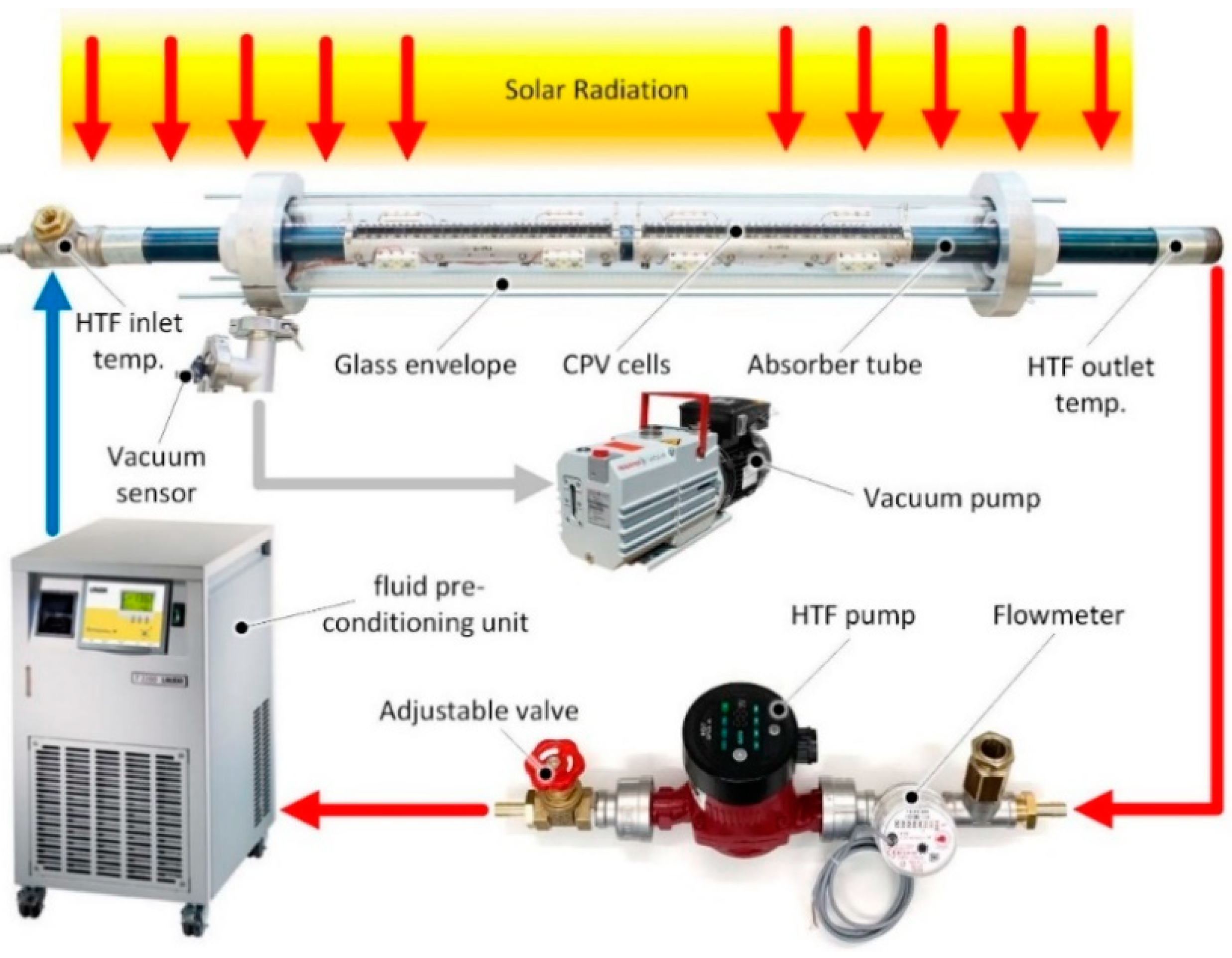
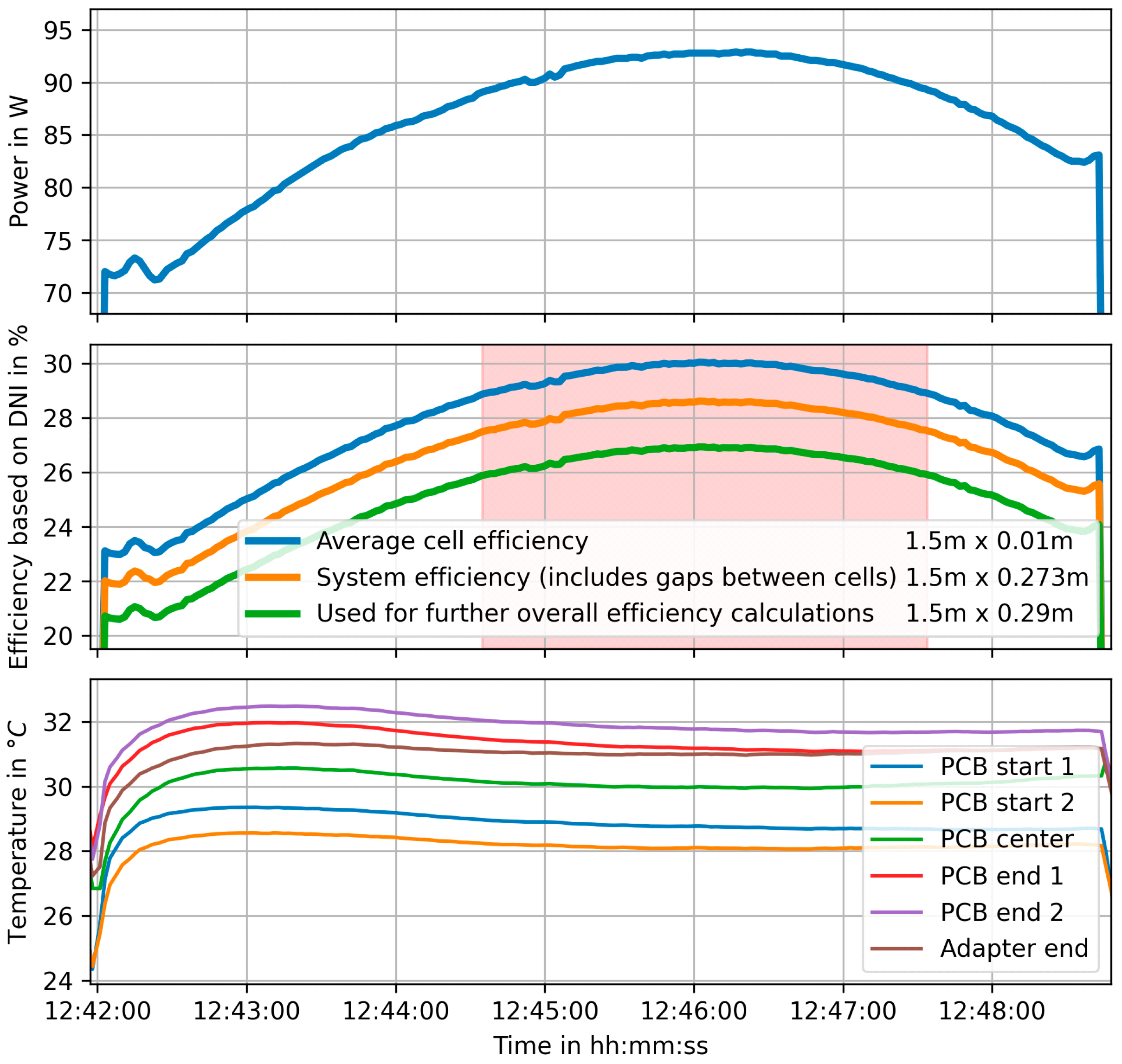
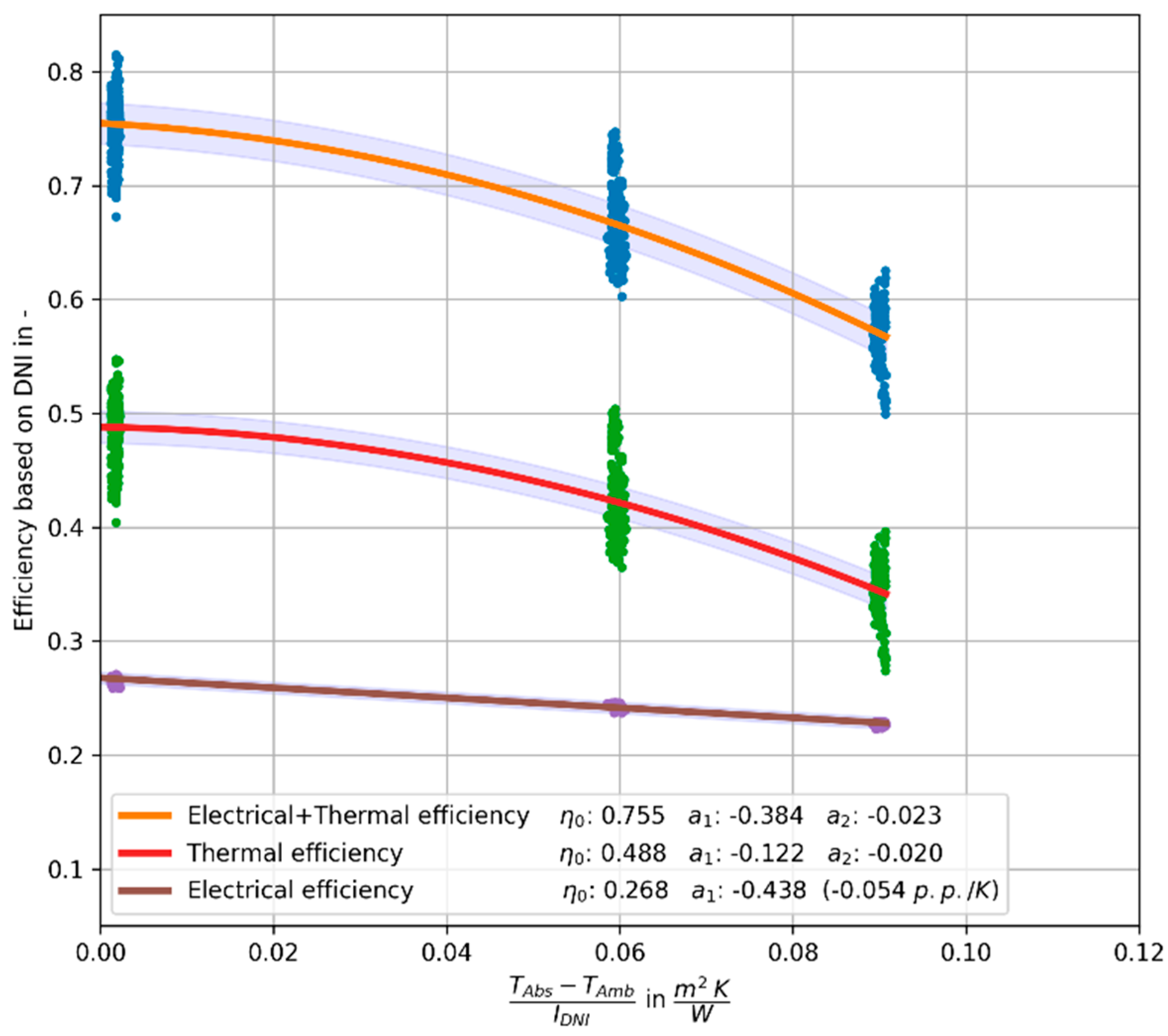


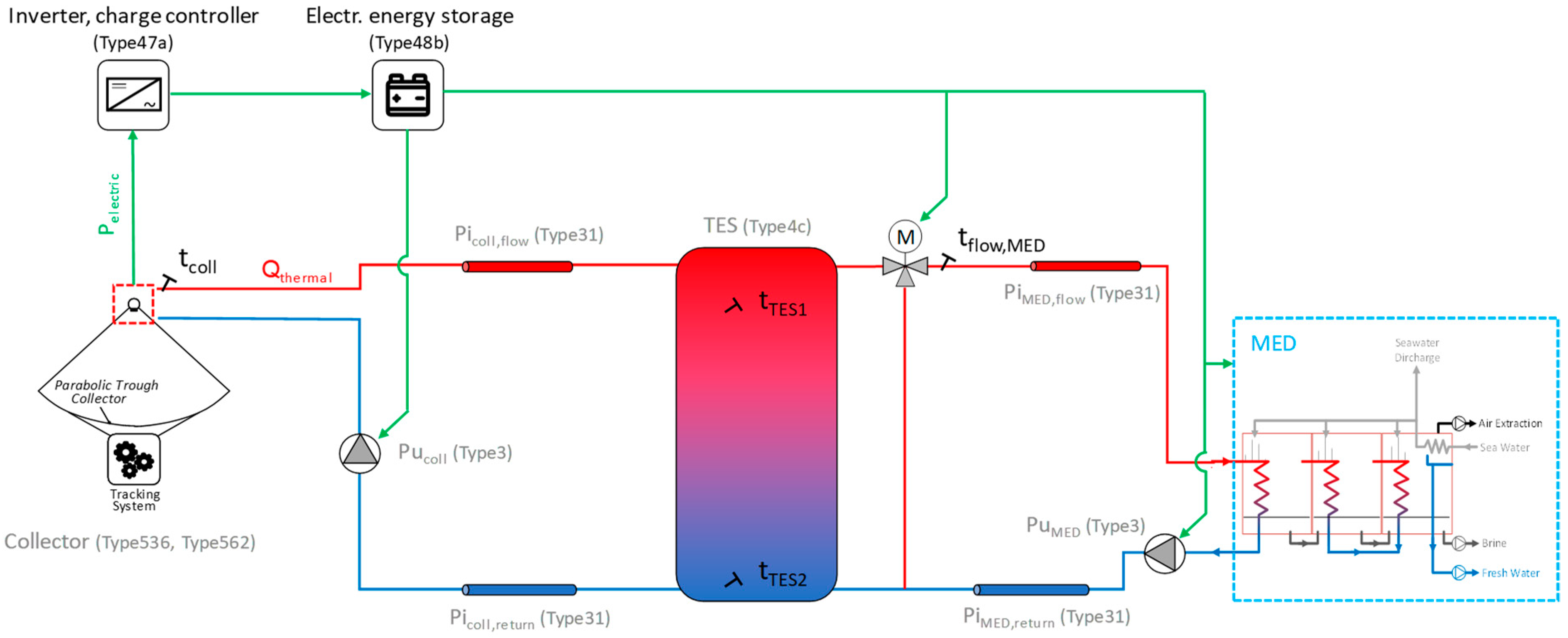
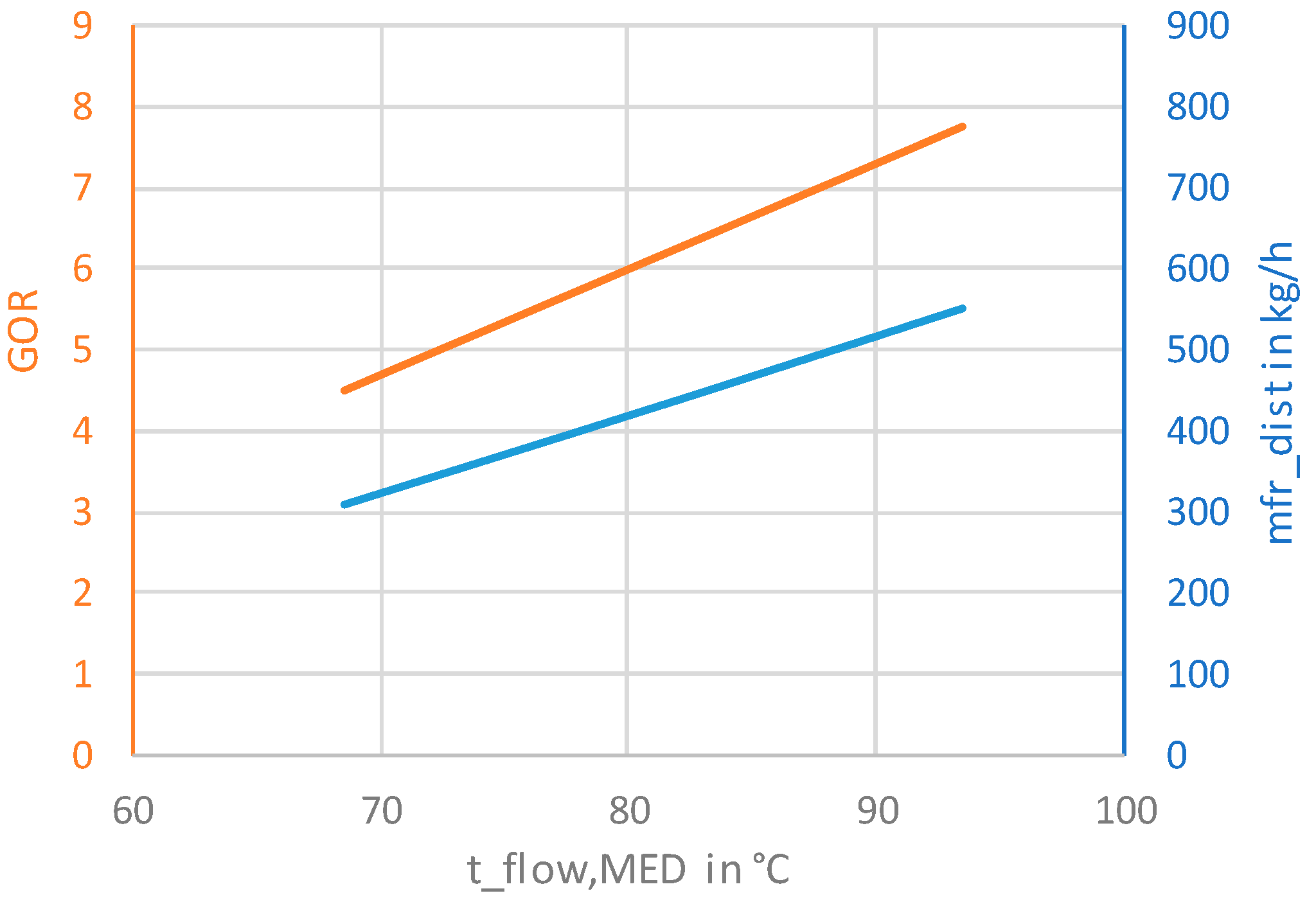
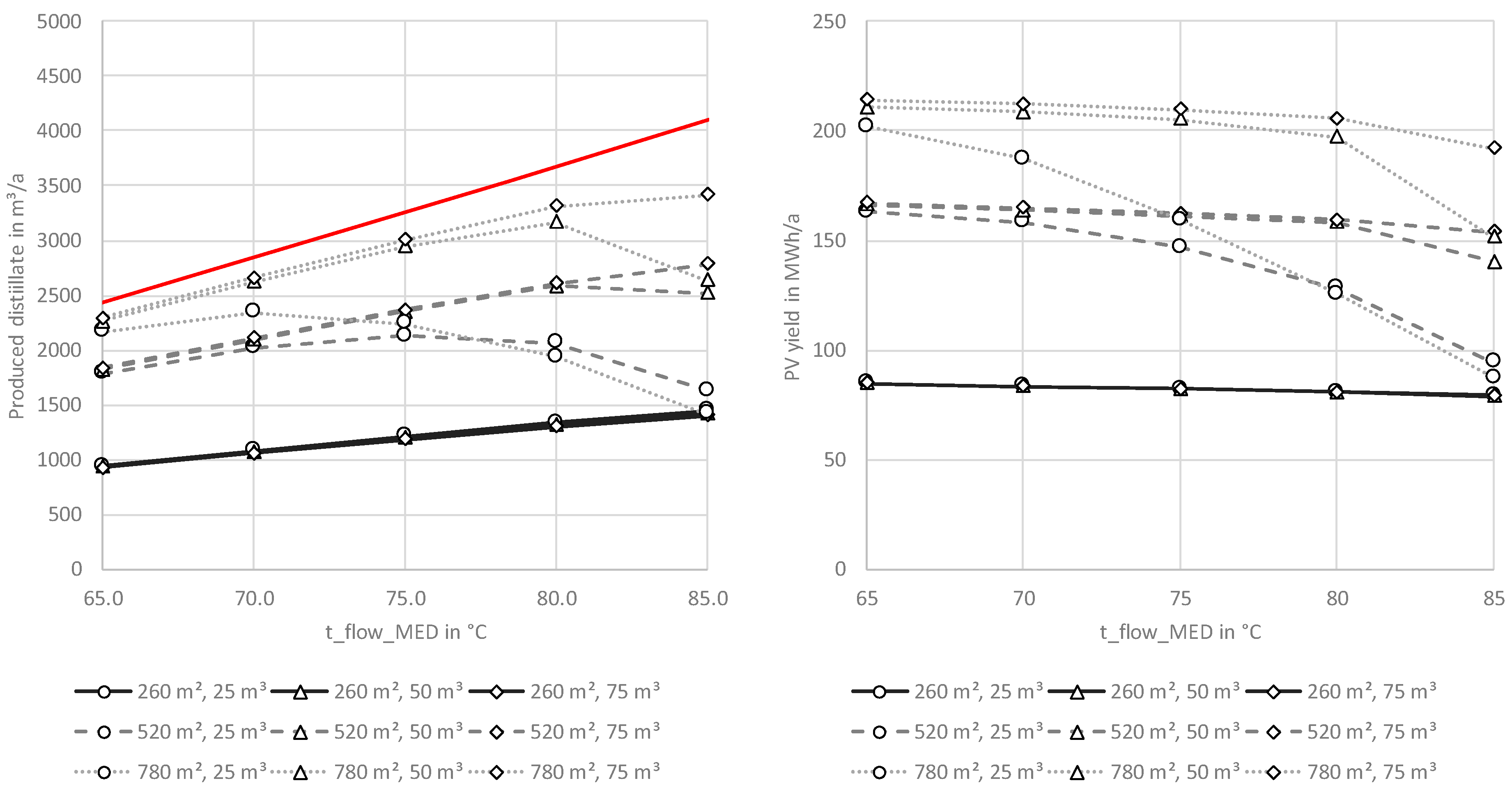

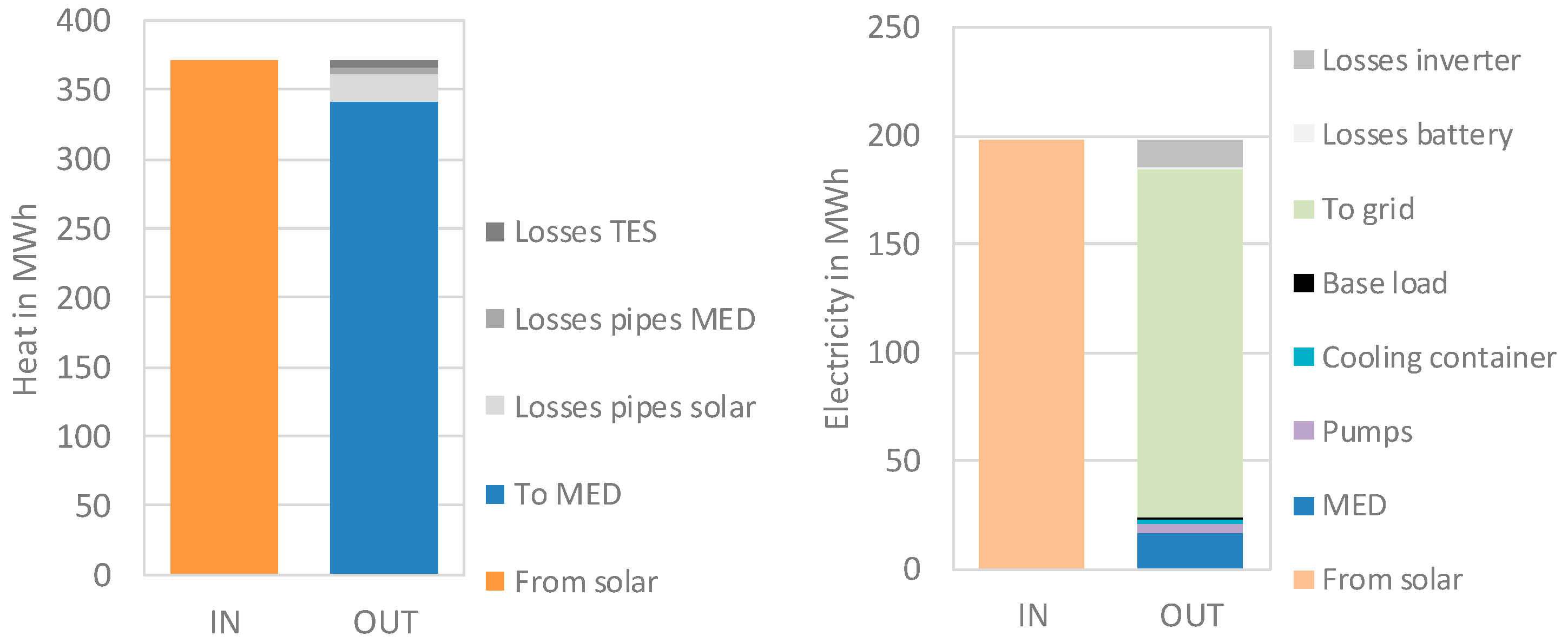

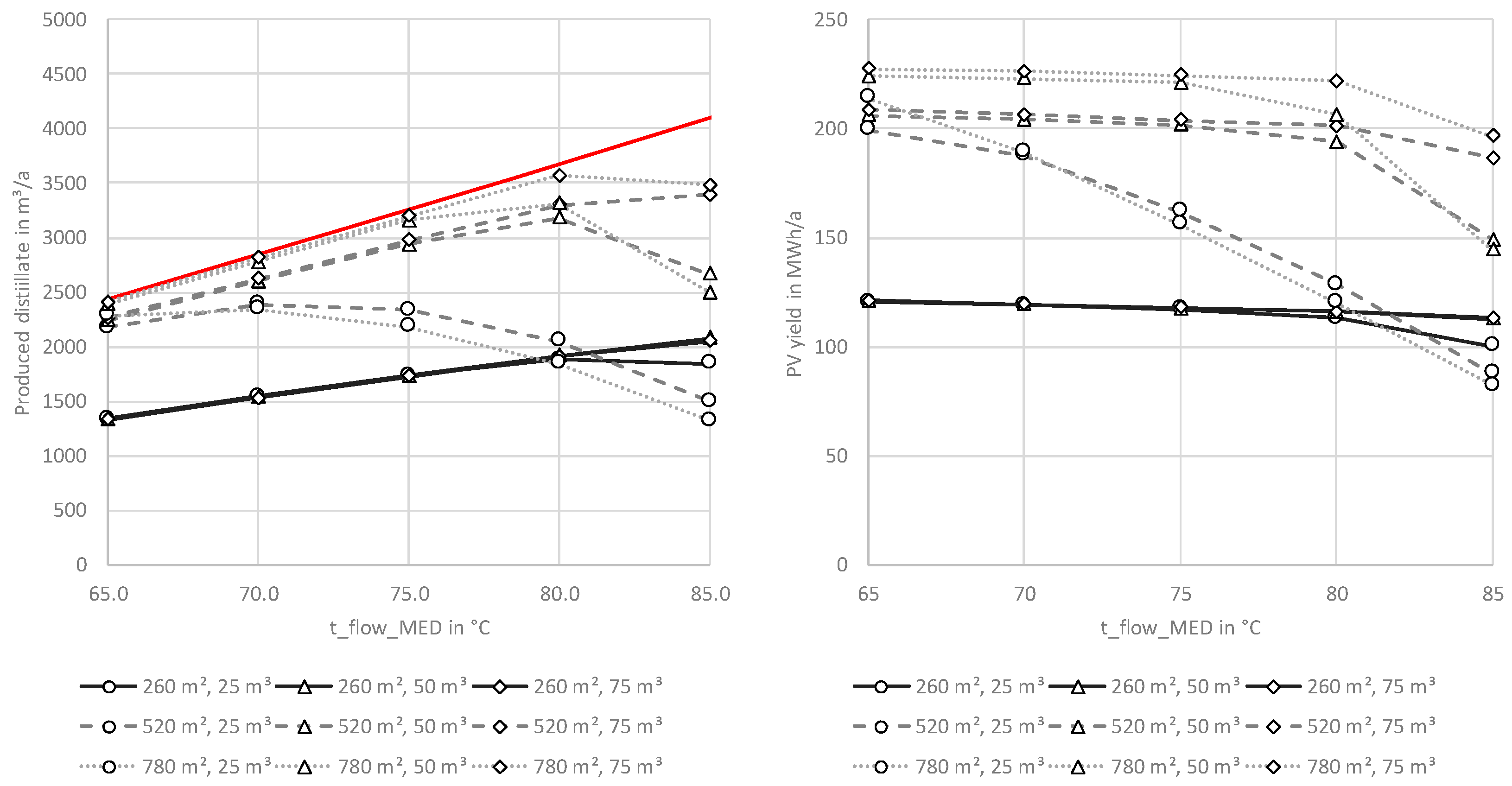
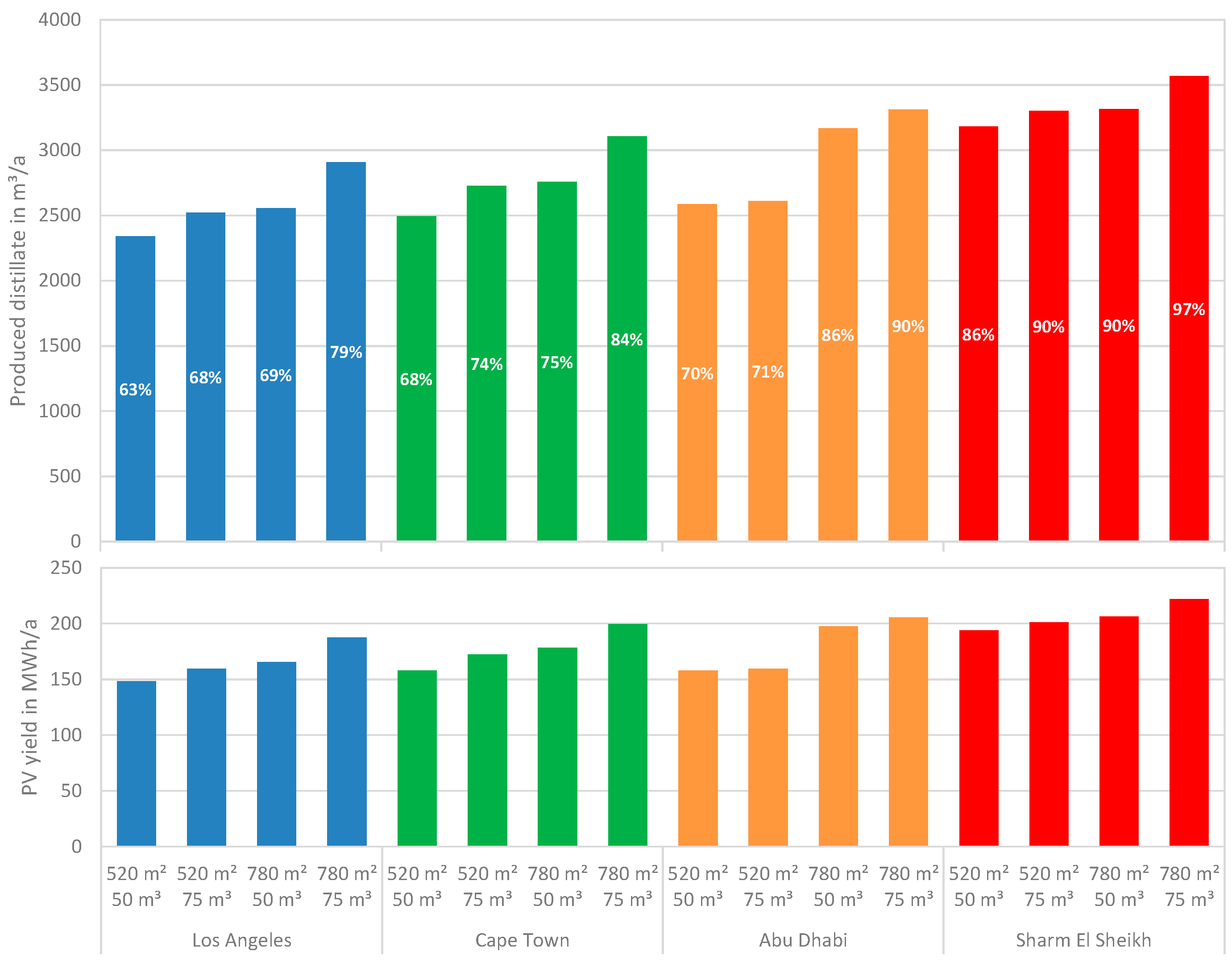
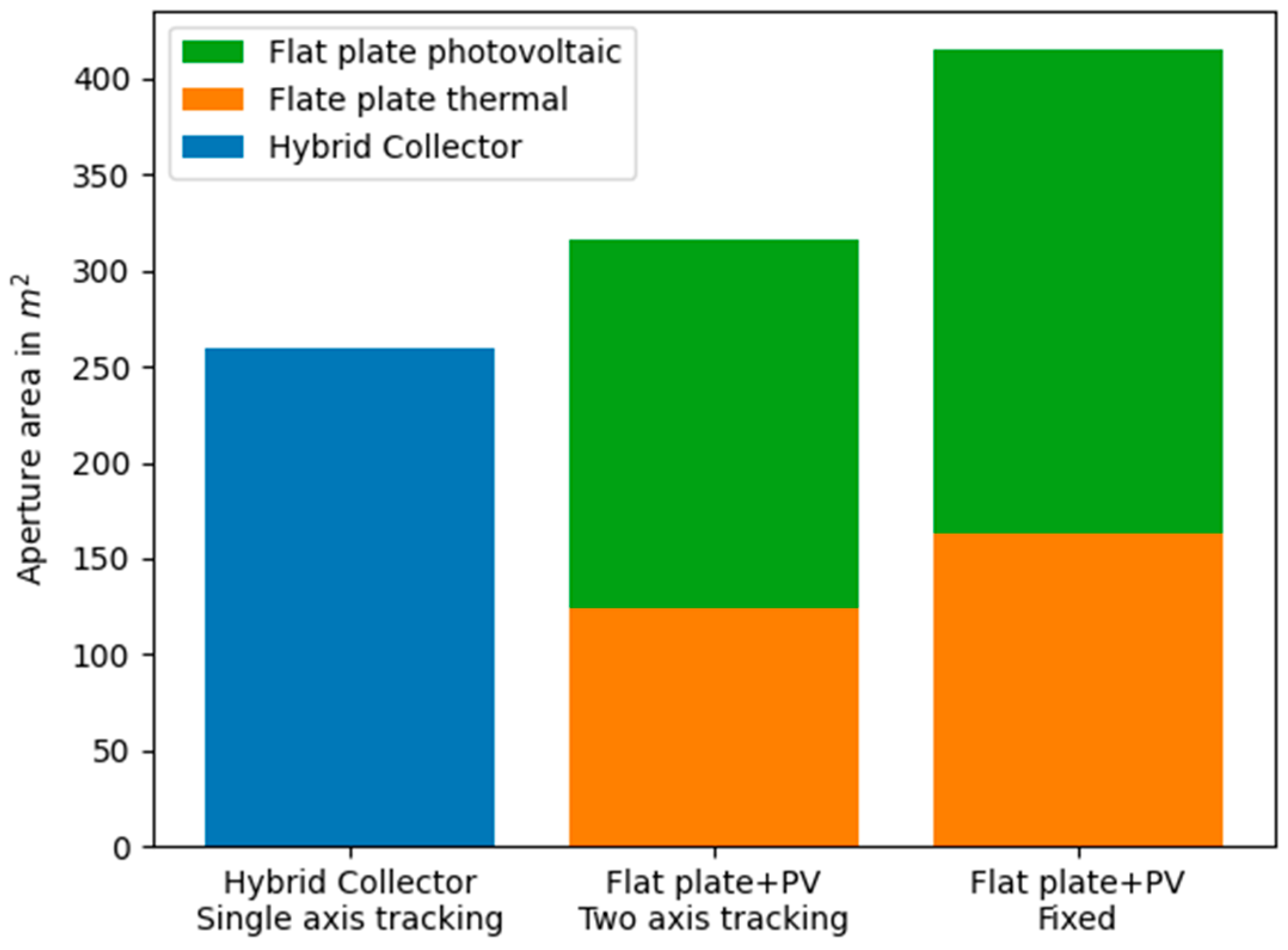
| Authors | Year | Concentrator | Absorber Technology | Cell Type | Electrical + Thermal Efficiency | Electrical Efficiency |
|---|---|---|---|---|---|---|
| Gibart [30] | 1981 | Parabolic trough | CPV-T | - | - | - |
| Rios et al. [31] | 1981 | Parabolic trough | CPV-T | - | - | - |
| Coventry [33] | 2003 | Parabolic trough | CPV-T | Si | 75% | 12% |
| Col et al. [34] | 2014 | Parabolic trough | CPV-T | Multi-junction | 72% | 20% |
| Yang et al. [37] | 2018 | Quasi parabolic mirror | CPV-T | Si | 57% | |
| Riahia et al. [36] | 2020 | Parabolic trough | CPV-T-TE | Si | 53% | 7% |
| Felsberger et al. [38] | 2021 | Parabolic trough | CPV-T | Multi-junction | 76% | 27% |
| Location | Longitude | Latitude | Altitude | avg. tAmbient | min tAmbient | max tAmbient | Global Radiation on Horizontal | Direct Normal Radiation | Diffuse Radiation |
|---|---|---|---|---|---|---|---|---|---|
| [-] | [°] | [°] | [m] | [°C] | [°C] | [°C] | [kWh/(m2a)] | [kWh/(m2a)] | [kWh/(m2a)] |
| Abu Dhabi | −54.5 | 24.4 | 3 | 28.8 | 10.6 | 47.8 | 2015 | 1584 | 931 |
| Cape Town | −18.6 | −34.0 | 44 | 17.0 | 1.3 | 36.3 | 1920 | 2173 | 623 |
| Los Angeles | 118.4 | 33.9 | 32 | 17.1 | 4.9 | 32.6 | 1823 | 1943 | 658 |
| Sharm El Sheik | −34.4 | 28.0 | 50 | 26.3 | 10.3 | 42.2 | 2115 | 2233 | 695 |
| Description | Unit | Value | Incident Angle | IAML |
|---|---|---|---|---|
| Concentration ratio * | - | 150 | 0 | 1.00 |
| Intercept efficiency c0 | - | 0.488 | 15 | 1.00 |
| First-order loss coefficient | W/(m2K) ** | 54.0 | 30 | 0.98 |
| Second-order loss coefficient | W/(m2K2) ** | 0.165 | 45 | 0.96 |
| Thermal capacity collector | kJ/(m2K) *** | 2.62 | 60 | 0.90 |
| HTF flow rate | kg/(m2h) *** | 30 | 75 | 0.71 |
| 90 | 0.00 |
| Description | Unit | Value |
|---|---|---|
| Reference PV efficiency @ TPV = 25 °C, IDNI = 1000 W/m2 | - | 0.358 |
| °C−1 | −0.002145 | |
| m2/W | 0.000196 | |
| Top emissivity | - | 0.006 * |
| Absorption coefficient | - | 0.9 |
| Back resistance to heat transfer between the bottom of the absorber plate and the back of the collector | M2K/W | 0.05 * |
| Bottom heat loss coefficient | W/m2K | 83 * |
| Pipe | Diameter in m | Length in m |
|---|---|---|
| Picoll,flow, Picoll,return | ||
| PiMED,flow, PiMED,return | 0.06 | 15 |
| Location | Avg. Cost of Electricity * | Cost of Heat by Natural Gas ** | Resulting Cost of Drinking Water *** |
|---|---|---|---|
| [-] | [EUR/kWh] | [EUR/kWh] | [EUR/1000 L] |
| Abu Dhabi | ~0.20 | 0.02 | 3.14 |
| Cape Town | ~0.12 | 0.025 | 3.275 |
| Los Angeles | ~0.29 | 0.07 | 8.94 |
| Sharm El Sheik | ~0.28 | 0.03 | 4.61 |
Disclaimer/Publisher’s Note: The statements, opinions and data contained in all publications are solely those of the individual author(s) and contributor(s) and not of MDPI and/or the editor(s). MDPI and/or the editor(s) disclaim responsibility for any injury to people or property resulting from any ideas, methods, instructions or products referred to in the content. |
© 2024 by the authors. Licensee MDPI, Basel, Switzerland. This article is an open access article distributed under the terms and conditions of the Creative Commons Attribution (CC BY) license (https://creativecommons.org/licenses/by/4.0/).
Share and Cite
Buchroithner, A.; Heinz, A.; Felsberger, R.; Schranzhofer, H.; Heimrath, R.; Preßmair, R.; Wegleiter, H. Sustainable and Self-Sufficient Fresh Water Through MED Desalination Powered by a CPV-T Solar Hybrid Collector: A Numerical and Experimental Study. Processes 2024, 12, 2732. https://doi.org/10.3390/pr12122732
Buchroithner A, Heinz A, Felsberger R, Schranzhofer H, Heimrath R, Preßmair R, Wegleiter H. Sustainable and Self-Sufficient Fresh Water Through MED Desalination Powered by a CPV-T Solar Hybrid Collector: A Numerical and Experimental Study. Processes. 2024; 12(12):2732. https://doi.org/10.3390/pr12122732
Chicago/Turabian StyleBuchroithner, Armin, Andreas Heinz, Richard Felsberger, Hermann Schranzhofer, Richard Heimrath, Rupert Preßmair, and Hannes Wegleiter. 2024. "Sustainable and Self-Sufficient Fresh Water Through MED Desalination Powered by a CPV-T Solar Hybrid Collector: A Numerical and Experimental Study" Processes 12, no. 12: 2732. https://doi.org/10.3390/pr12122732
APA StyleBuchroithner, A., Heinz, A., Felsberger, R., Schranzhofer, H., Heimrath, R., Preßmair, R., & Wegleiter, H. (2024). Sustainable and Self-Sufficient Fresh Water Through MED Desalination Powered by a CPV-T Solar Hybrid Collector: A Numerical and Experimental Study. Processes, 12(12), 2732. https://doi.org/10.3390/pr12122732








